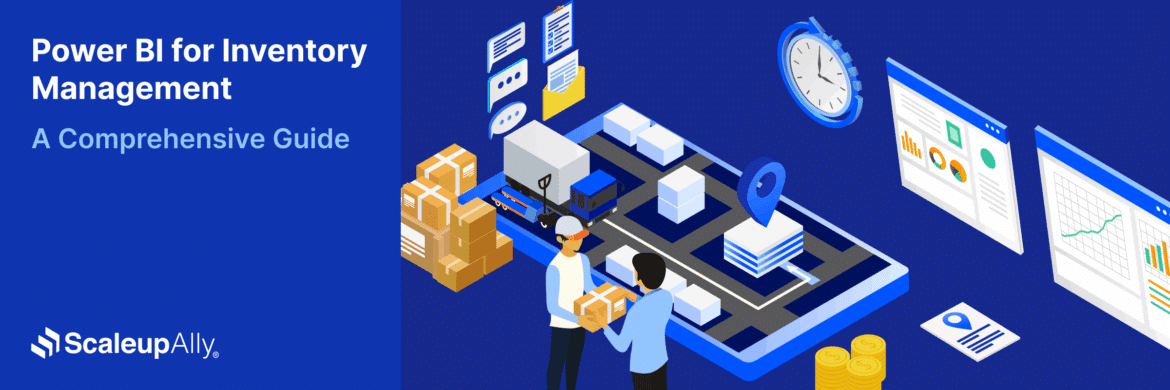
13 Business Intelligence Best Practices for 2025
Tarsem Singh | March 6, 2025 , 14 min read
Table Of Content
The global market for business intelligence is growing, and experts predict it will reach $41.94 billion by 2030.
For leaders, professionals, and stakeholders in various industries, incorporating business intelligence into their work processes is essential for staying competitive, optimising data-based strategies, and making well-informed decisions.
As we approach 2025, noticeable Business Intelligence best practices are emerging. This article will detail the top 13 Business Intelligence practices for 2025 and beyond.
These real-world stories show how BI can transform different industries. Whether in retail or healthcare, the key takeaway is clear – using BI effectively leads to informed decision-making, operational efficiency, and long-term success.
Key Takeaways
- Clearly define BI objectives, KPIs, and measurable goals to ensure data initiatives align with overarching business strategies.
- Foster a data-driven culture across all levels, empowering employees to make informed decisions based on actionable insights.
- Choose scalable, user-friendly BI tools, maintain high-quality, integrated data, and ensure consistent, reliable reporting across teams.
- Promote close collaboration between IT and business units, ensuring BI solutions address real needs and deliver tangible value.
- Continuously monitor performance, mitigate risks with security and compliance measures, and refine BI processes for ongoing success.
Why Following Business Intelligence Best Practices is Crucial?

Business Intelligence (BI) is no longer a nicety but a core business process, especially as industries experience an unprecedented explosion of data. However, simply having analytics tools and dashboards isn’t enough to unlock its true potential. Achieving real BI transformation requires a structured, strategic approach that emphasizes governance, scalability, and accessibility. When BI systems are designed as adaptive and reliable extensions of decision-making processes, they become powerful drivers of business growth and agility.
By adopting proven BI best practices, companies can:
- Enhance Data Quality & Integration: Unified, high-quality data across all departments ensures consistent and reliable insights.
- Provide Actionable Insights to Every User: Intuitive reporting allows employees at all levels to access and use data for smarter decision-making.
- Scale Efficiently with Business Growth: A well-designed BI system evolves alongside growing operational and analytical demands without unnecessary costs.
- Ensure Security & Compliance: Strong data governance frameworks protect sensitive information and ensure regulatory compliance.
- Drive Continuous Innovation: Advancements in BI techniques enhance speed, efficiency, and the overall impact of analytics.
BI is no longer just about collecting and visualizing data—it’s about empowering organizations to make smarter, faster, and more strategic decisions
With that being said now let’s tackle some BI best practices.
Business Intelligence Best Practices for Success
By following these practices, businesses can build a strong foundation for their BI initiatives in 2025. Enabling them to make better-informed decisions and stay ahead of the competition.

1. Define Clear Objectives
Clearly define the objectives of your business intelligence initiative.
- To define clear objectives, understand your business goals and how data can support them. For example, a retail company aiming to increase online sales might analyze customer behavior on its website to improve the user experience and drive conversions.
- Once the objectives are defined, break them down into specific metrics or Key Performance Indicators (KPIs) that will be used to measure progress. This could include conversion, average order value, or customer retention rates.
Templates for defining BI objectives and KPIs, such as the business impact analysis (BIA) template, are available online.
2. Foster a Data-Driven Culture
Foster a culture where data is valued and used to make decisions at all levels of the organization.
- Foster a data-driven culture by promoting the importance of data in decision-making across all levels of the organization. This could involve organizing workshops or training sessions to improve employee data literacy.
- Encourage employees to use data to support their decisions. For example, instead of relying solely on intuition, a marketing manager could use data from past campaigns to optimize future marketing strategies.
This guide from MIT will help you build data literacy in your company.
3. Choose the Right BI Tools
Select BI tools that align with your organization’s needs, capabilities, and budget.
- When choosing BI tools, consider your organization’s specific needs, your data’s complexity, and your team’s technical expertise. For example, a small business with limited technical resources might opt for a user-friendly, cloud-based BI solution.
- It’s also important to consider the scalability of the BI tool. As your business grows, you’ll want a tool that can grow with you and handle larger volumes of data and more complex analyses.
For an in-depth comparison of some BI tools, read our article on Power BI vs Tableau.
4. Emphasize Data Quality
Ensure that your data is accurate, complete, and consistent.
- Data quality is crucial for reliable insights. Establish data quality standards that outline how data should be collected, stored, and maintained. For example, a healthcare provider might have strict protocols for recording and updating patient data in their systems.
- Regularly audit and clean your data to ensure it remains accurate and up to date. This could involve running automated data validation checks or manual reviews of data sets.
5. Foster Collaboration Between IT and Business Teams
Encourage collaboration between IT and business teams to ensure BI initiatives align with business goals and requirements.
- Collaboration between IT and business teams ensures that BI initiatives align with business needs. This could involve regular meetings between the two teams to discuss project requirements and progress.
- Involve business users in the BI development to ensure the final solution meets their needs. For example, a retail company might involve its sales team in designing a new sales performance dashboard to ensure it provides the right insights for driving sales growth.
Also Read: How Business Intelligence is Beneficial for Retail Industry?
6. Implement Security Measures
Protect your data and BI infrastructure from unauthorized access, breaches, and other security threats.
- Implement security measures to protect your data and BI infrastructure. This could include data encryption, multi-factor authentication, and regular security audits.
- Train employees on best practices for data security to minimize the risk of data breaches. For example, employees should be educated on recognizing phishing attempts and handling sensitive data securely.
7. Craft Intuitive BI Dashboards
Design BI dashboards that are user-friendly, intuitive, and provide actionable insights.
- When designing BI dashboards, consider the needs and preferences of the end users. This could involve conducting user surveys or interviews to gather feedback on what information is most valuable to them.
- Use visualizations that effectively communicate key insights at a glance. For example, a bar chart showing sales performance by region can quickly highlight which regions are performing well and which need improvement.
8. Empower Users with Training
Provide training and support to empower users to use BI tools and interpret data effectively.
- Provide training that is tailored to the specific needs of different user groups. For example, a data analyst might require more technical training in using advanced analytics tools, while a sales manager might need training in interpreting sales reports.
- Offer ongoing support and resources, such as online tutorials or a knowledge base, to help users continue to develop their skills over time.
9. Continuously Monitor and Evaluate
Continuously monitor the performance of your BI initiatives and evaluate their impact on business outcomes.
- Continuously monitor key metrics to track the performance of your BI initiatives. This could involve setting up automated alerts for when certain metrics deviate from expected values.
- Regularly gather feedback from users to identify areas for improvement. For example, if users find a particular report difficult to understand, it may need to be redesigned for better clarity.
10. Drive Continuous Improvement
Foster a culture of continuous improvement where BI processes and practices are regularly reviewed and refined.
- Foster a culture of continuous improvement by encouraging feedback and being open to making changes based on that feedback. This could involve setting up regular feedback sessions with users to gather their input on improving BI processes.
- Use data from your BI system to identify areas for improvement. For example, if a marketing campaign didn’t perform as well as expected, you could use the data to analyze what went wrong and make adjustments for future campaigns.
11. Seamless Integration with Existing Systems
For BI implementation to be truly effective, it must integrate smoothly with existing systems without disrupting essential business operations.
Rather than undertaking an expensive and complex system overhaul, companies should focus on creating a unified data infrastructure that connects diverse databases, applications, and data sources. Partnering with experienced BI providers can simplify this process through modern APIs, cloud-based data warehousing, and real-time synchronization, ensuring a seamless data flow.
Additionally, close collaboration between IT teams and business stakeholders helps align technical capabilities with strategic goals, ensuring that data remains easily accessible for analysis without interfering with day-to-day operations.
12. Ensuring Scalability and Flexibility
As businesses grow, their data needs evolve. A well-architected BI system should be scalable, adaptable, and future-proof, capable of handling increasing data volumes, shifting business models, and new analytics demands.
Cloud-based infrastructures, flexible data models, and modular BI solutions allow companies to scale efficiently without incurring unnecessary costs.
Additionally, data storage strategies should accommodate future growth, enabling seamless integration of new data fields or dimensions.
Meanwhile, outdated or redundant data should be systematically archived or retired in order to maintain optimal system performance.
13. Keeping Up with Emerging BI Trends
The BI landscape is constantly evolving, with advancements in artificial intelligence, predictive analytics, and real-time insights transforming how businesses harness data. Staying ahead requires a commitment to keeping a tab on latest trends, continuous learning, proactive technology adoption, and a willingness to embrace innovative solutions that enhance analytics capabilities.
Organizations that leverage cutting-edge BI technologies gain a competitive edge by making faster, more accurate, and more strategic data-driven decisions.
Common BI Implementation Mistakes and How to Avoid Them
Implementing Business Intelligence (BI) can transform decision-making, but common pitfalls often hinder its success. Here are five key mistakes businesses make and how to avoid them:
1. Lack of Specific Goals: Many companies implement BI without clearly defined objectives, leading to inefficiency and confusion.
Solution: Set measurable BI goals aligned with business outcomes, such as improving sales forecasting or optimizing supply chain operations.
2. Poor Data Integration & Quality: Inaccurate, inconsistent, or siloed data can reduce BI’s effectiveness.
Solution: Establish strong data governance policies, conduct regular data audits, and ensure seamless integration across all business systems.
3. Selecting the Wrong BI Tools: Choosing overly complex or misaligned BI tools can lead to low adoption and wasted investment.
Solution: Select BI tools that fit your organization’s needs, technical expertise, and scalability requirements. Conduct user testing before full deployment.
4. Overlooking User Training & Adoption: Employees may resist BI adoption if they don’t feel confident using the tools.
Solution: Provide continuous training, hands-on workshops, and role-based education to encourage a data-driven culture.
5. Neglecting Security & Compliance: Weak security measures can result in data breaches and regulatory violations.
Solution: Implement strict access controls, encryption, and routine security audits to protect sensitive business data.
Real-world Success Stories of Business Intelligence Transformations
Let’s explore some real-life examples where organisations used Business Intelligence (BI) to adapt and thrive in their industries.
1. Boosting Profits with Smart Data Use
Picture a big retail chain that needed to improve its inventory management for better profits. They used BI tools to analyse customer buying patterns, inventory changes, and seasonal trends. This detailed analysis helped them manage inventory better, reduce excess stock, prevent stock shortages, and ultimately increase their profits. For more insights on improving inventory management, learn more here.
2. Customising Success for Each Customer
In online shopping, a forward-thinking platform used BI to understand customer data better. They created targeted marketing plans by dividing their diverse customer base by demographics, behaviour, and past purchases. The result? Increased customer engagement, personalised promotions, and a significant rise in conversion rates and customer loyalty. For a real-life example of how to analyze customer behaviour, read our Case Study.
3. Making Supply Chains More Efficient
A big manufacturing company transformed its supply chain using BI. BI tools helped them monitor in real-time, find bottlenecks, optimise production schedules, and reduce lead times. The result was a more efficient supply chain, saving costs, improving efficiency, and making it easier to adapt to market changes.
4. Improving Patient Care with Analytics
A forward-thinking hospital used BI to change how they care for patients. By studying large datasets with patient information and treatment outcomes, the hospital optimized how it allocated resources, improved operations, and raised the standard of patient care. Predictive analytics helped them anticipate patient admission rates, ensuring timely and efficient staff deployment. To understand a use case of BI in the healthcare industry, read our Case Study.
Conclusion
Looking ahead to 2025 and beyond, the world of business intelligence is changing fast. As we make decisions based on data, it’s super important for your business to stay on top, and following the best practices is the way to go.
ScaleUpAlly has the latest and best Business Intelligence services. We’ve designed them to help your business scale. You will keep up with the latest trends and be a leader with us.
Don’t wait – take action now and use the skills of our ScaleUpAlly team. Let’s work together to reach new goals for your business.
These real-world stories show how BI can transform different industries. Whether in retail or healthcare, the key takeaway is clear – using BI effectively leads to informed decision-making, operational efficiency, and long-term success.
Frequently Asked Questions
Q: What is the most important part of business intelligence?
The most important part of business intelligence is data quality and accessibility. Accurate and well-integrated data enables meaningful analysis and without reliable data, even the best BI tools fail. Additionally, making insights accessible to all stakeholders ensures BI drives real business impact and strategic growth.
Q. How can I ensure the security of my BI infrastructure?
Implement security measures such as encryption, access controls, and regular security audits. Stay informed about cybersecurity trends and update your security protocols accordingly. Employee training on data security is also essential to mitigate internal risks.
Q. What makes a BI dashboard effective?
An effective BI dashboard is intuitive, visually appealing, and aligned with the user’s needs. It should prioritise key metrics, offer easy navigation, and cater to technical and non-technical users. Regularly update dashboards based on user feedback and evolving business requirements.
Q. How can I integrate ethical considerations into BI practices?
Integrate ethical considerations by ensuring compliance with data privacy regulations. Establish clear guidelines for ethical data usage within your organization. Transparency in data practices builds trust with customers and stakeholders and safeguards against legal and reputational risks.
Q. Can AI be used in BI for automation, and how does it benefit organizations?
Yes, AI can be leveraged for automation in BI, streamlining routine tasks such as data cleansing and report generation. This enhances efficiency and allows human resources to focus on more strategic and high-value tasks, driving overall productivity and accuracy.
Related Blogs

Data Warehouse Cost Breakdown: Factors, Pricing Models & Platform Comparison
Discover how much a data warehouse costs in 2025. Explore pricing models, key factors, and platform comparisons to plan your data budget effectively.
Tarsem Singh
Nov 6 ,
14 min read

How Much Do Integrations Cost? [Pricing Breakdown & Key Insights]
Learn how much integrations cost, key factors influencing pricing, hidden expenses to avoid, and effective ways to reduce integration costs.
Tarsem Singh
Nov 6 ,
9 min read

Power BI for Inventory Management: A Comprehensive Guide
Explore the hidden power of Power BI for inventory management and how it provides businesses with powerful analytics and visualization capabilities.
Tarsem Singh
Oct 8 ,
19 min read



